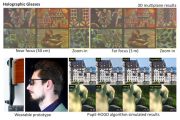Nvidia and Stanford Develop Downsized Holographic Glasses
August 16, 2022
Engineers at Nvidia have teamed with Stanford University researchers to develop a virtual reality headset that looks and feels more like a regular pair of eyeglasses, according to a research paper presented at SIGGRAPH 2022. The “Holographic Glasses” can depict scenes in full-color 3D holographic images using optical lenses that are just 2.5mm thick. The so-called “pancake lenses” not only have a slimmer profile, but also offer a 200-degree field of view and the potential for resolution that is virtually unlimited and can be “cranked up” at will.
Today’s traditional VR headsets work using a lens that magnifies a smaller display, positioned at a distance. The Nvidia/Stanford team’s achievement “shrinking all the prerequisite parts down to such a small size is quite the spectacular step forward for VR,” PC Gamer writes.

While pancaked VR lenses are not new, this new iteration builds on previous prototypes, which “managed to use them to reduce the gap between the lens and the screen to a tiny fraction of today’s VR headsets,” but only displayed 2D images, and thus weren’t suitable for immersive experiences.
The Holographic Glasses from Stanford and Nvidia break new ground by “delivering both 3D images and minimizing the gap between lens and screen,” PC Gamer says, explaining that “the research paper lists the glasses as such: ‘a coherent light source that is coupled into a pupil-replicating waveguide, which provides the illumination for a phase-only SLM that is mounted on the waveguide in front of the user’s eye. This SLM creates a small image behind the device, which is magnified by a thin geometric phase (GP) lens.’”
The end result, a small and lightweight VR eyepiece “could be game-changing if made a reality outside of the lab,” per PC Gamer, which adds the Holographic Glasses weigh only about 60 grams, “notably far lighter than even the Meta Quest 2, which rolls in at 503 grams.”
“The design remains rudimentary at this point with film ribbons that extended from each lens,” reports Digital Trends, noting that “overall, it would take a larger company to invest in this concept to bring it to life in a consumer fashion.” Meta Platforms, purveyor of the Quest 2, is one well-funded company with a wide array of prototype VR headsets in development, as unveiled in June.
Newer technological breakthroughs are “expected to benefit the brand’s long-rumored VR headset, currently known as ‘Project Cambria,’ or the Meta Quest Pro,” Digital Trends writes, adding that “Apple is rumored to be developing its own mixed-reality headset, which is rumored to weigh just 150 grams.”

No Comments Yet
You can be the first to comment!
Sorry, comments for this entry are closed at this time.